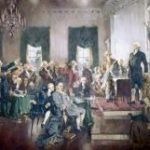Explore the role of third-party candidates and how the American political system makes it very difficult for anyone outside the Republican or Democratic Party to win the White House. Registration is required to view this resource.
Political Ideology in America: Bumper Sticker Politics
Americans love to personalize their vehicles in a way you will not see in many other countries. This lesson explores political ideology by analyzing data on automobile purchases and bumper stickers. Students will learn generalizations about conservatives, liberals, Democrats, Republicans, libertarians, socialists and appreciate the American custom of advertising political thought in public. Free registration required to access the lesson plan.
Government and Politics Infographics
A set of government and politics infographics that teachers can print out for their students, use for their exams, or use to create posters for their classroom.
The Constitution as a Fulfillment of the American Revolution

This short video challenges the notion that the Constitution was a conservative reaction to the democratic ideals of the American Revolution. The Revolution generated constitutional discussion in the states, where legislators explored the nature of executive power, and other constitutional questions. In light of this constitutional innovation, Professor Jack Rakove maintains that the Constitution of 1787 was the culmination of—not a reaction to–the Revolution of the late 1770’s.
Election 2016 Case Study: Entering the Race
In 2016, 22 people led the field of Republicans and Democrats running for president. They were joined by about 1,800 third-party, fringe and joke candidates. But is this field as open as it seems?